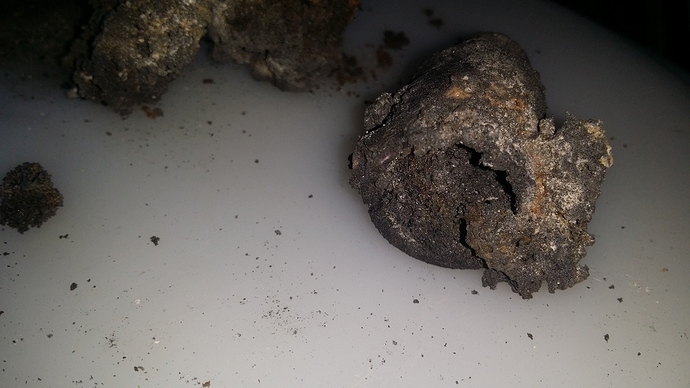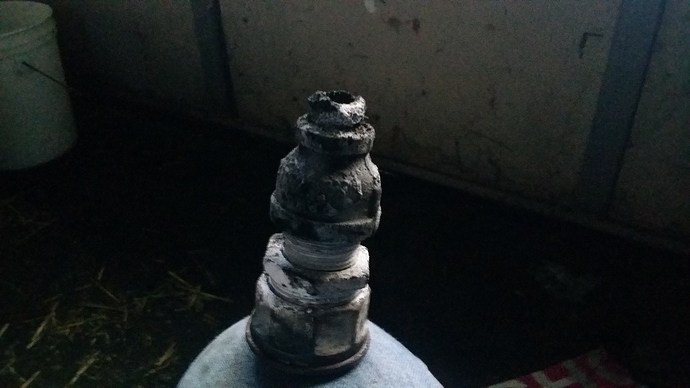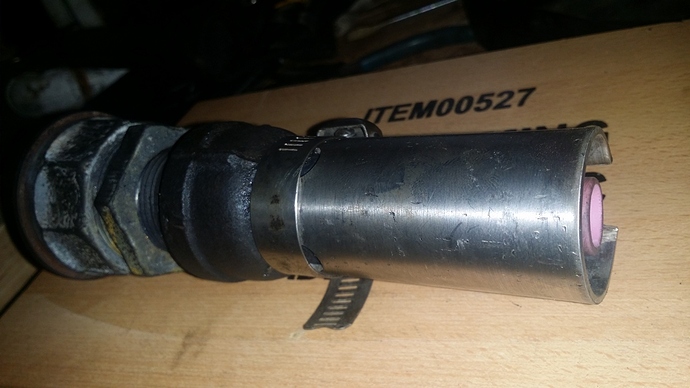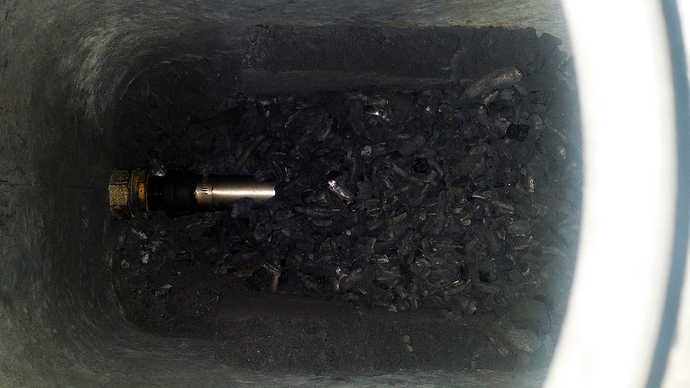He used some charcoal that was slightly larger and melted his stainless nozzle into a puddle
Thanks Bill for convincing me on the phone today to vacuum out the charcoal to make sure the ceramic nozzle did actually burn up. Well it did not burn up because I found it. It was buggered up with clinkers and it had a crack in the side. What I think happened is that the black iron pipe nipple, that I ground the threads to allow the cup to slip on and turn enough so I couldn’t pull it off, expanded more than the tig cup causing it to crack and fall partially off when I poked in there with a wire and then filled with ash and clinkers. Then the black pipe nipple became the nozzle but couldn’t take the heat and melted.
Does this make any sense?
Interesting. I was glad to see you call. I know nothing about charcoal gasifiers but keep my eyes and ears open on others projects because I want to make one.
Sooooo… Would you conclude that ceramic and metal are not conducive together in a charcoal gasifiers? Or just not so close to the heat? What I mean is maybe if the ceramic was longer, it may have been okay?
I recall that @AlDenninger had a piece of rolled stainless steel slid over his inlet pipe.
I think you got it right Bill. I am going to try cutting slits in the end of the pipe to allow for expansion and make the cup a loose fit and then cover it with rolled stainless and fine ashes and see what happens.
Hey Don ,
Looks a little like what I had after my run at Argos I think I will try the same set up of 1.25"black iron pipe with a reducer down to 1" a brass nipple to screw the tig cup on only this time I will slide a tube of stainless over brass and the tig cup .My son scraps a lot so I have him save me all the handles off the BBQ grills they seem to work out perfect cut a piece off then cut a X on one end use a band clamp to hold on.it what I use when I just use the black iron pipe maybe this will help. Dan
Dan, am I hearing this right that you are using a 1 inch nozzle? I tried that after I had this apart and it took a long time to start making gas. After it finally got to making good gas (sustain a flare) the engine ran fine. It seems like we need a smaller nozzle with high velocity for quick starts and then the engine also seems to run just fine with the smaller nozzle. I am thinking about packing ash between the 1/2" nipple and the stainless sleeve for added insulation.
Here is what I made up tonight
1/2" short nipple turned down to fit inside diameter of cup and then slotted for expansion protection.
Assembled nozzle with stainless sleeve around.
Nozzle assembly installed in place.
That actually -looks- really good. I hope it holds up. I would guess the expansion is the problem. it is pretty hard to get the expansion right between metal and ceramic.
I am wondering if you could hold the ceramic on with a spring attached to keep a butterfly valve open, then when it breaks off it closes the butterfly valve. then that saves the iron… but probably not worth it.
Don,
I have a #10 and a #12 left they both seem to have a 3/4" hole that I reduce down, my fire tube starts out with a 1" ball valve attached to a 3" threaded black iron pipe attached to a 1"x 1.25 " bell reducer attached to a 1.25" threaded black iron pipe then I drill a 1.25" hole through a 2" black iron cap run the 1.25" threaded pipe through the cap on the inside of cap screw on another 1.25"x 1" bell reducer you will need to drill a 2" hole in your tank take a 2"x 4" black iron nipple cut in half weld on to tank then take the 2" cap screw it on the tank then weld the 1.25 " black iron pipe through the cap make sure to leave enough pipe thread to attach 1.25 " X 1" bell reducer that way I can use any thing from 1.25" on down .
I was wondering what if you ran your black iron pipe to the center of your container that way it should have more draw and a better heat zone plus more gas. Will try to send pics of fire tube .Dan
I really like the shield over the ceramic. I suppose depending on how fast the incoming air is, the shield could actually extend well past the ceramic? Say if the rpms remained constant? Or maybe even a ceramic shield?
Dan, how long after you start your system are you making good enough gas to run an engine?
Sean and Don,
In an ideal world I would water jet the TIG cup in half down the centerline and then hose clamp it to the end of the pipe. That would eliminate all the expansion stress issues.
You could also cut the cup with a diamond scroll saw blade:
Stephen
Sean and Don,
One last throught…Is your nozzle pointed at the exit pipe? That would likely help stretch the flame out in front of the tip and get the heat away from the metal parts. Otherwise, the gas will start to turn immediately at the end of the nozzle tip and retain more heat closer to the metal. This helped a lot in the Victorias.
Stephen
Don,
I can get it to flare after 3 to 5 mins once you get the generator going you can turn the vac off and the engine will pull the gas in Dan
So here are our results. Our square gasifier worked beautifully - thanks to Dan Hartman for an excellent workshop. It appears that our 30 gallon reserve will run the 27 hp Power Cube for 4 hours. Based on this success, we look forward to bulldozers running on char soon. Redirecting... See the bulldozer workshop coming up - http://opensourceecology.org/bulldozer-workshop/
Congratulations on a job well done. Marcin. I just went back to the first post on this thread and realized this is really your thread and I have been hi-jacking it big time. Sorry. 
Congrats Marcin looks good.
Alright, another convert to the dark side of wood (charcoal) 
Glad the workshop went well with good success. Keep it up!
Gary in PA
stephen,
The expansion slot might work if you use the spring action hose clamps. but you have to get it tightened back up to prevent air from coming out…
Ceramic stresses with heating and cooling cycles too so breakage is part of the game. I was just thinking shutting off the inlet, when it broke could save the iron from burning up, and give you kind of a notification that it happened so you didn’t have to guess.
So just a couple of tiny holes drilled in and a wire going through might hold it enough to keep tension on the return spring of a butterfly. (I was originally thinking just loop it over the end of the cup with grooves but you probably need tungsten wire to handle the heat.) In fact, it could almost be mated against a flat surface or one with a ridge in it with the guard over the top of it to help prevent the down pressure on it., then maybe some rtv stuff to try and seal it, but mostly to help it stick.
I enjoyed the workshop Marcin (but not the heat!) but I am wondering about the long term endurance of the metal box being only 8" thick.





